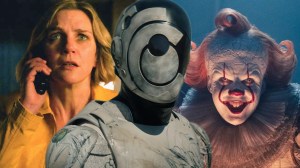
Christopher Nolan’s newest film Interstellar aims to drop jaws. Nolan wants to present audiences with the majesty of the universe and leave them in awe. In its best moments, Interstellar achieves the sort of spectacle that he desires. However, it is often overwhelmed by his urge to explain and marvel at his own clockwork construction. The resulting film occasionally achieves greatness, but is never allowed to maintain it.
Videos by ComicBook.com
It’s worth noting that when Interstellar is at its best, it is remarkable. I am exceedingly glad that I saw Interstellar in an IMAX theater. In these best moments the film is an immersive experience, one that overwhelms visual and auditory sense. The massive screen and booming sound system are both intended to be part of the experience and Nolan is capable of using them to masterful effect.
This first becomes obvious when the four-man crew tasked with finding a new habitable world in order to rescue humanity from a dying Earth launch into space. Nolan uses footage from an IMAX camera attached to a Lear jet flying through the stratosphere and the stunt translates the velocity and intensity of atmospheric flight well. It’s shocking to watch the hull shake under the enormous forces of space travel. The real grandeur comes when the ship is shown in juxtaposition to the enormity of space though. Once the crew leave Earth behind, it is possible to take some time to ponder the desolate beauty of the universe. An IMAX screen helps to make the void of space feel all the more encompassing.
As beautiful as space is shown to be, the planets visited by these four explorers are every bit as magnificent. The film contains two central planetary set pieces: one a world covered in water and massive waves, another composed of frozen clouds and warped, layered stone geography. These locales are marvelously presented and well realized. It never feels as if these places are artificial or the result of a blue screen. Nolan takes a page from Spielberg providing ample practical effects to blend reality and CGI together seamlessly.
The cast grounds these cold, distant worlds as well. Matthew McConaughey provides the emotional center for the film in the role of Cooper, a pilot turned farmer who goes to space desiring to save his children. His performance proves to be very necessary by the end of the film. If he were not selling the impact of each scene, it’s very possible that Interstellar would have quickly become lost in its own plotting. Instead, McConaughey demands the audience’s attention and belief selling every moment of desperation, wonder, or passion with complete authenticity.
Cooper’s fellow astronauts Brand (Anne Hathaway), Doyle (Wes Bentley), and Romilly (David Gyasi) compose an effective if underused supporting cast. Brand and her father (Michael Caine) are both made to be believable and empathetic characters even when the script drives them to inane philosophizing. The standout performance from the supporting cast is given by Bill Irwin who voices TARS a robot that is bound to draw comparisons to HAL 9000 of 2001: A Space Odyssey. He is provided no anthropomorphic features, relying entirely on Irwin’s vocal performance to inflect emotion and build character. Yet TARS is the role that elicited the most laughs and biggest reactions from the audience for most of the film.
That comparison to 2001 is not accidental; Kubrick’s masterpiece is scrawled across the DNA of Interstellar and Nolan seems to invite comparison. Unfortunately, that comparison quickly reveals the seams and flaws of Interstellar. Both films possess very similar aims: to present the majesty of time and space, while exploring the nature of mankind. Nolan’s film possesses little of the grace, complexity, or ambiguity that make 2001 a classic though.
2001 allows the audience to revel in the experience of space travel and, eventually, movement beyond space into a strange tesseract formed of color. It presents marvels and trusts viewers to explore them. At its best Interstellar comes close to this when showing the audience wonders, rather than telling us about them. Nolan possesses none of Kubrick’s detachment from or faith in the audience though and often interferes with the experience. He is obsessed with explaining the manner in which his story is functioning and holding the audience’s hand to ensure they know how all of the pieces fit together.
Watching Interstellar is like traveling to the Grand Canyon, but being forced to spend the majority of your time in a museum about the Grand Canyon. Rather than being allowed to stroll along paths and contemplate the marvel of nature, you are given answers about how the monument was formed and its history with precise dates and details. The grandeur of the experience is removed through extraneous exposition. Nolan weighs the film down with so many explanations that the natural, beautiful moments become an exception to his clockwork structure.
This is most obvious in the film’s climax. It is a moment that ought to draw the audience in and provide a supernatural sense of mystery to the universe. Yet the conclusion has been telegraphed from the earliest moments of the film so that it feels inevitable and obvious. Early in the movie the supernatural entity of “them” is introduced and accepted by a roomful of scientists. Strange, impossible happenings occur that can only be explained by an outside influence. There is no subtlety in how these moments are presented so when an explanation arrives, it is necessary rather than surprising.
These flaws are further exacerbated by inter-cutting between scenes on Earth and in space throughout the film’s middle section. Everything occurring on Earth is extraneous to the plot and could easily be presented through the messages being sent to the explorers. The editing of these sequences badly damages the momentum of the explorer’s journey. As the movie makes some of its most significant revelations, the story jumps to unnecessary sub-plots of dying crops and lung disease.
Just like Nolan’s script and direction, the sound mixing is determined to pound the significance and meaning of every moment into the audience. There are plenty of scenes where a loud, overwhelming score is earned, but the volume continues for so long that it becomes a drone. After the mid point of the movie, there is little room for quiet or meditation and Hans Zimmer’s score loses its ability to effect the audience. It’s a problem that was present in The Dark Knight Rises, but becomes more obvious here.
Nolan’s ample exposition is ultimately unnecessary. Interstellar is not a thematically or emotionally complex story. The concepts it presents and the emotional arcs undertaken by Coop, his family, and fellow scientists are easy to follow. It does not possess the complexity of 2001 and raises no demanding questions. That is not a flaw in itself, as the emotional arcs are effective and the journey grand. There is no need for Nolan to painstakingly expose the inner workings of his story though. So his efforts to infinitely explain a simple story are needless and detract from the parts of the film that work.
Interstellar is capable of summoning a simple, but effective emotional core and pairing it with masterful imagery and experiences. There is a strong and effective center to this film. That is also what makes Nolan’s obsession with his own machinations and need to explain every detail all the more troublesome. Rather than let the audience experience the emotions and majesty on the screen, he chooses to distract them with details and exposition. The result is a film worth seeing, one that is disappointing not because it is bad, but because it only occasionally recognizes its own potential.
Grade: B-








